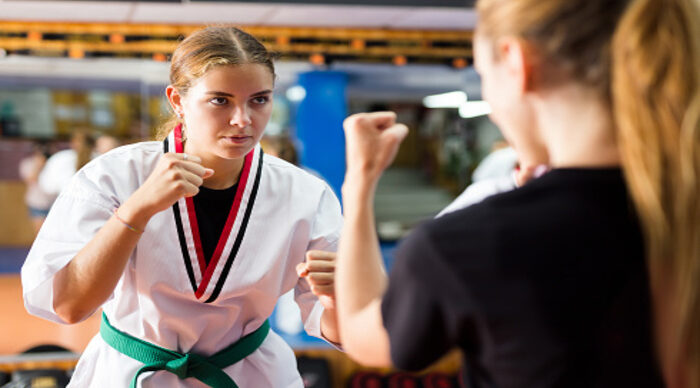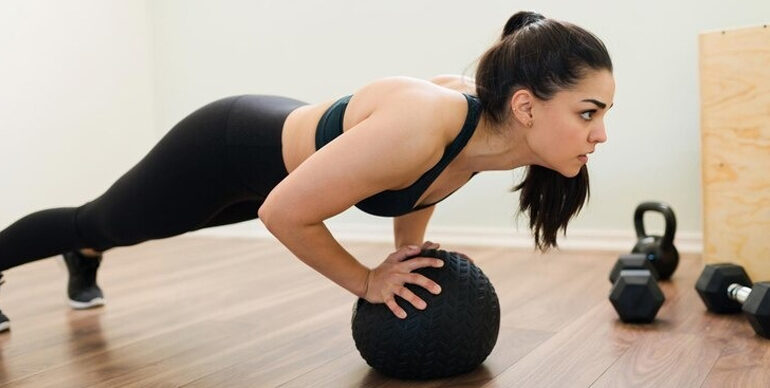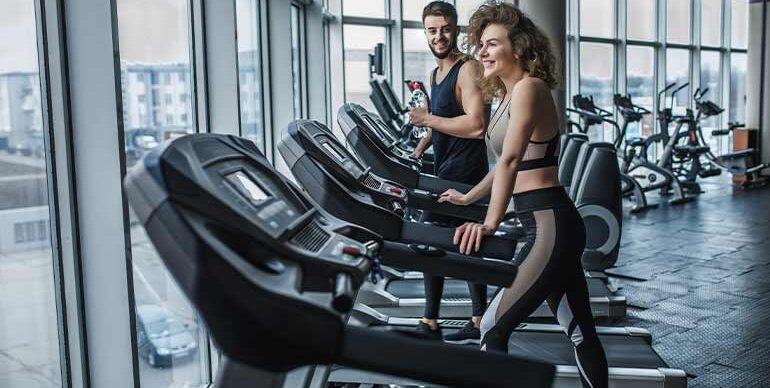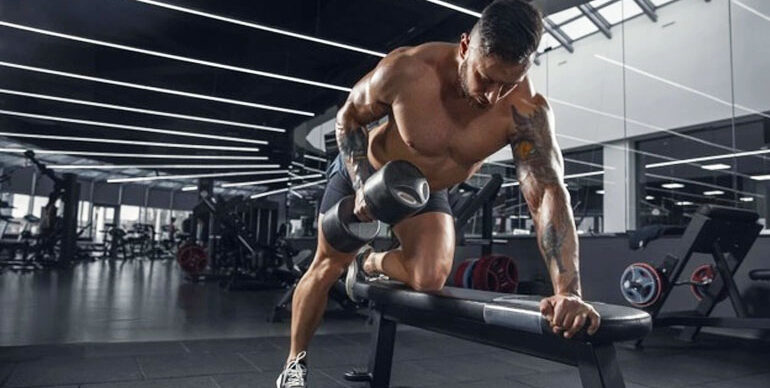
Initiation Routine for New Kickboxing Students
A kickboxing or fitness boxing regime consists of a two-to-three-hour educational workout from which the participant derives fitness benefits. The safety gear, such as boxing gloves and wraps are considered mandatory while other safety equipment such as foot and shin guards could be an option. Failing to use proper hand protection whilst participating in this activity could result in injury.
We begin with a warm up of cardio which consists of air attack moves or skipping. The kickboxing instructor then demonstrates the methods and techniques to be utilized ahead. A point to be noted – size should be taken into consideration, meaning the opponents should be equivalent in terms of height, weight, fitness and skill levels.
We move on into simulated competitive matches which have 30 to 60 seconds rest and water breaks. Here one partner acts like the striker and the other as the defender.
Highly vigorous workouts are planned for advanced sessions and optional sparring classes could be made available for them.

Kickboxing Health Advantages to Participants
- Easy to learn
- Stress relief
- Flexibility
- Safety
- Toning
- Fat loss
- Variety
- Self confidence
Moving on from the outdated equipment of the 50’s to the 90’s we are fortunate enough to be in the 21st century where we are introduced to fantastic training methods such as Pilates and the Stability Ball.
Over the last few years boxing and kickboxing have become extremely popular as fitness training in India. This is due to the fact, that you learn valuable self-defence skills and get the best cardiovascular and resistance workout ever.
In addition to losing weight, during a kickboxing session you are building lean muscle as well as raising your metabolism burning calories. Thus, you are sculpting and toning your entire body. Here, you decide your intensity along with your partner unlike traditional aerobics where the same pace is maintained throughout the class.
Once the basics are learnt, the combinations and permutations are endless providing a constant flexibility in your routine. Boxing and kickboxing are exceptional ways to improve agility, endurance and coordination.
So, kick start your fitness program today with a knock out routine!
Setting Goals and Recognition
Here participants are divided into three categories: Beginners, Contenders (intermediate) and Champs (advanced). Fitness boxing and kickboxing are designed such that the advantages and benefits can be realized in a span of six to twelve months whereas martial arts take years of diligent and sustained training to achieve desired results.
Just like other programmes that offer certification, fitness boxing and kickboxing can also offer an incentive or recognition program. These are at the sole discretion of the instructor and depend on the level of training and basic techniques demonstrated by the participant.
It is an accepted fact that fitness training shows its most noticeable benefits in the first eight to twelve weeks. So, the beginner kickboxing program should be built over two-to-three-month period. From there we move on to the contender level which last from twelve to twenty weeks, and implement more strenuous and physically challenging training.
Lastly, the champ level incorporates strenuous cardiovascular muscle movement pattern as well optional sparring.
History of Kickboxing

Kickboxing has its roots in martial arts and it began as a sport in the early 1970s as an alternative to karate.
Those participating in martial arts that involved kickboxing soon adopted the boxing stance. Rules and protective equipment were implemented due to the heightened risk of injury.
As opposed to the traditional gym workout, people find fitness boxing and kickboxing to be more fun, challenging and invigorating.
Vent your frustrations from your daily routine of the work day as you punch, kick, bob and weave your way into the best shape of your life. It is an experience that will motivate you as well as tone your muscles and build your endurance. Go for it – Pack a punch!
Lets Get Started
The “do it yourself” fitness test before you start.
Before you start a fitness programme at home you need to assess your endurance levels. The following is an extremely simple home fitness test you can perform yourself. This includes cardio vascular endurance, core, upper and lower body, strength and flexibility.
- Cardiovascular endurance
Time yourself on a walk or a run on a pre-measured one-mile distance. Repeat the same test after you have started the programme and make a comparison to check on improvement.
- Upper body
Push ups are a good indicator of upper body strength. Do as many as you can and note the score.
- Core, abdominals and back
Perform partial sit ups by lying on your back and place your palms on your thighs, raising your torso upward until bring your fingers to the top of your knees. Do as many as you can and lock the score.
- Lower body
A good indicator can be squats. Start by sitting at the edge of a chair with your knees jutting out at right angles. Stand up and sit back down refraining from touching the chair and immediately stand back up. Repeat until you cannot properly perform anymore repetitions and note the score.
- Flexibility
Try to touch your toes with your palms standing straight and bending at the waist. Make a note how close you come to placing your palms flat on the floor.
Perform all the components of the test again in eight weeks to check your progress.
In order to attain overall fitness, it should be noted that four main areas have to be covered. They are known as the Primary Components of Fitness.
Primary Components of Fitness

- Body composition: This refers to the proportion of body fat compared to lean mass also popularly known as Body Mass Index (BMI). A high BMI is generally indicative of health risks such as heart disease, high cholesterol, diabetes etc.
- Resistance training: This involves traditional weight training accompanied by weight training with machines and free weights. Build resistance power in your training sessions. This helps in improving posture and could help to keep osteoporosis at bay as well as prevents the loss of muscle due to aging.
- Cardiovascular training: Basically, cardio workouts should give your heart a healthy workout. It should be something you enjoy doing and that you are motivated to keep up to it. It could be walking, biking or dancing. Whatever you prefer and interests you. The benefits of cardiovascular exercise are immense as they reduce the risk of hearty disease and helps normalize blood pressure.
- Flexibility training: This should be done before and after each training session. After any workout it is imperative to stretch your muscles. Especially after your routine it is important to stretch your warm and worked up muscles to reduce the incidence of injury. It also helps to restore the natural length to the ligaments and tendons.
Secondary Components of Fitness
These involve skills and abilities such as balance, agility, coordination, balance and mental capacity. Whatever your motivation may be, it could be to stay fit or to lose weight or build muscle mass, you must start off with a well-balanced program, stick to the basics and build a safe and efficient routine around it that keeps you motivated.
Fitting SMART fitness goals into your program:
S for SPECIFIC
Be specific on your targets. You can’t just want to lose weight. That’s too general. Set a target. I need to lose this much weight. Then you will work towards it. Write out specific goals and keep yourself in check.
M for MEASURABLE
How will you know when you have achieved your goals? Define them clearly for yourself so that you know when you have attained them both in the short term as well as long term. For example, if your activity is cardiovascular fitness check your heart rate per minute so you can see the reduction as you progress.
A for ATTAINABLE
Please set goals that are realistic. If you decide you are going to lose 50 pounds in a month that is unrealistic and not unattainable. Therefore, set a sensible and attainable goal for yourself.
R for REALISTIC
Are you being true to yourself? For example, if you have a heavy workload or you commute far to your office everyday it is highly unlikely that you will go the gym every day, if that is the target you have set for yourself. You must set realistic targets for yourself.
T for TIME TARGETED
How long will this take? Create a timetable for yourself in order to achieve your for-fitness goals. Short term goals should be 8 to 12 weeks and long term between 6 to 12 months.
Decode your current fitness program and understand the necessary changes you need to incorporate in order to achieve your fitness goals. Be a SMART player and set realistic targets in order to achieve your desired results. Put you best foot forward and go for it. You will never know the outcome unless you try!
Do not miss a single article!
Submit your email id to get new articles directly into your email inbox!
- How We Conduct Online Zumba Sessions for Employees - December 30, 2022
- Prenatal Yoga During First Trimester - December 14, 2022
- Healthy Eating and Nutrition at the Workplace - October 13, 2022




Add Review